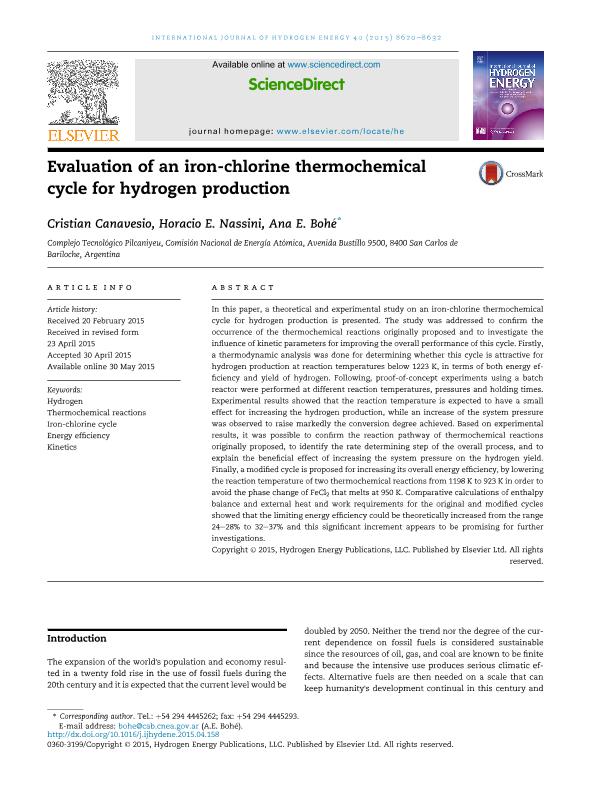Mostrar el registro sencillo del ítem
dc.contributor.author
Canavesio, Cristian Alberto

dc.contributor.author
Nassini, Horacio E.
dc.contributor.author
Bohe, Ana Ester

dc.date.available
2018-05-28T15:42:18Z
dc.date.issued
2015-07-30
dc.identifier.citation
Canavesio, Cristian Alberto; Nassini, Horacio E.; Bohe, Ana Ester; Evaluation of an iron-chlorine thermochemical cycle for hydrogen production; Pergamon-Elsevier Science Ltd; International Journal of Hydrogen Energy; 40; 28; 30-7-2015; 8620-8632
dc.identifier.issn
0360-3199
dc.identifier.uri
http://hdl.handle.net/11336/46247
dc.description.abstract
In this paper, a theoretical and experimental study on an iron-chlorine thermochemical cycle for hydrogen production is presented. The study was addressed to confirm the occurrence of the thermochemical reactions originally proposed and to investigate the influence of kinetic parameters for improving the overall performance of this cycle. Firstly, a thermodynamic analysis was done for determining whether this cycle is attractive for hydrogen production at reaction temperatures below 1223 K, in terms of both energy efficiency and yield of hydrogen. Following, proof-of-concept experiments using a batch reactor were performed at different reaction temperatures, pressures and holding times. Experimental results showed that the reaction temperature is expected to have a small effect for increasing the hydrogen production, while an increase of the system pressure was observed to raise markedly the conversion degree achieved. Based on experimental results, it was possible to confirm the reaction pathway of thermochemical reactions originally proposed, to identify the rate determining step of the overall process, and to explain the beneficial effect of increasing the system pressure on the hydrogen yield. Finally, a modified cycle is proposed for increasing its overall energy efficiency, by lowering the reaction temperature of two thermochemical reactions from 1198 K to 923 K in order to avoid the phase change of FeCl2 that melts at 950 K. Comparative calculations of enthalpy balance and external heat and work requirements for the original and modified cycles showed that the limiting energy efficiency could be theoretically increased from the range 24–28% to 32–37% and this significant increment appears to be promising for further investigations.
dc.format
application/pdf
dc.language.iso
eng
dc.publisher
Pergamon-Elsevier Science Ltd

dc.rights
info:eu-repo/semantics/openAccess
dc.rights.uri
https://creativecommons.org/licenses/by-nc-sa/2.5/ar/
dc.subject
Hydrogen
dc.subject
Thermochemical Reactions
dc.subject
Iron-Chlorine Cycle
dc.subject
Energy Efficiency
dc.subject
Kinetics
dc.subject.classification
Otras Ciencias Químicas

dc.subject.classification
Ciencias Químicas

dc.subject.classification
CIENCIAS NATURALES Y EXACTAS

dc.title
Evaluation of an iron-chlorine thermochemical cycle for hydrogen production
dc.type
info:eu-repo/semantics/article
dc.type
info:ar-repo/semantics/artículo
dc.type
info:eu-repo/semantics/publishedVersion
dc.date.updated
2018-05-21T17:22:28Z
dc.journal.volume
40
dc.journal.number
28
dc.journal.pagination
8620-8632
dc.journal.pais
Estados Unidos

dc.journal.ciudad
Nueva York
dc.description.fil
Fil: Canavesio, Cristian Alberto. Consejo Nacional de Investigaciones Científicas y Técnicas. Centro Científico Tecnológico Conicet - Patagonia Norte; Argentina. Comisión Nacional de Energía Atómica. Gerencia Complejo Tecnológico Pilcaniyeu; Argentina
dc.description.fil
Fil: Nassini, Horacio E.. Comisión Nacional de Energía Atómica. Gerencia Complejo Tecnológico Pilcaniyeu; Argentina
dc.description.fil
Fil: Bohe, Ana Ester. Consejo Nacional de Investigaciones Científicas y Técnicas. Centro Científico Tecnológico Conicet - Patagonia Norte; Argentina. Comisión Nacional de Energía Atómica. Gerencia Complejo Tecnológico Pilcaniyeu; Argentina
dc.journal.title
International Journal of Hydrogen Energy

dc.relation.alternativeid
info:eu-repo/semantics/altIdentifier/url/https://www.sciencedirect.com/science/article/pii/S0360319915011209
dc.relation.alternativeid
info:eu-repo/semantics/altIdentifier/doi/http://dx.doi.org/10.1016/j.ijhydene.2015.04.158
Archivos asociados
